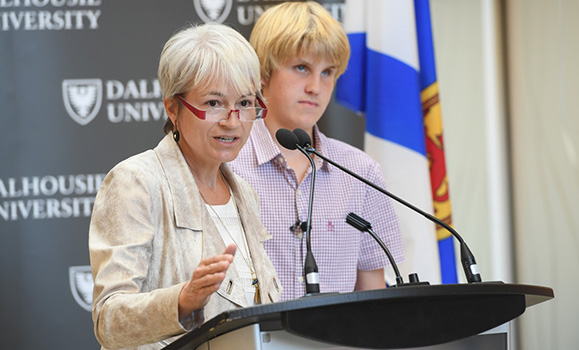╣√╜┤╩╙╞╡ Medical School researchers believe theyтАЩve discovered a drug that will prevent babies born with a genetic blinding disease called Familial Exudative Vitreoretinopathy (FEVR) from losing their vision.
тАЬWeтАЩve got what we think is a very good drug,тАЭ says Dr. Chris McMaster, professor and head of the Department of Pharmacology. тАЬIt can cure animal models. Now we have to figure out the right dose and ensure its safety before administering it to kids.тАЭ
From gene to therapy
When Halifax ophthalmologist Dr. Johane Robitaille and her team discovered the FEVR gene in 2002, it was a major breakthrough that generated international buzz. She found that when the gene is mutated, veins and arteries in the retina arenтАЩt able to develop properly. Identifying this gene allowed scientists to start looking for ways to repair the mutation.
тАЬOne of the nice things about discovering the gene is that it tells you, biochemically, what goes wrong,тАЭ says Dr. McMaster. тАЬOnce you know what goes wrong, you can start hypothesizing what you need to tweak in order to fix the problem, which is the first step in drug discovery.тАЭ
тАЬThis drug would enable the vessels in the retina to grow and complete their development,тАЭ says Dr. Robitaille, a professor in the Department of Ophthalmology & Visual Sciences who specializes in ocular genetics. тАЬWe can facilitate that with this therapy, so that we can prevent the FEVR-related complications from happening. It would work directly against the pathology that causes the blindness.тАЭ
The research teamтАЩs work is funded through a $2 million award from the Atlantic Canada Opportunities Agency, . The money will be used to test toxicity and efficacy of the FEVR drug, and then move it into clinical use.
Read more:
тАЬIt would be a cureтАЭ
Currently, thereтАЩs no treatment available to address the cause of the disease; doctors can only manage complications.
тАЬWe try our best to maintain the vision that people do have,тАЭ says Dr. Robitaille. тАЬBut FEVR patients have a life-long risk of developing problems that will rob them of the rest of their sight. This drug could protect them for life. They wouldnтАЩt have the constant worry that maybe theyтАЩll lose their vision one day. The drug would treat the cause of the blindness тАФ it would be a cure.тАЭ
Dr. Robitaille met 14-year-old Nick Gentleman when he was a baby. He was diagnosed with FEVR early in life, and today his vision is limited. NickтАЩs little brother, Matthew, also has the disease.
тАЬMatthew and I are very excited about this awesome news,тАЭ says Nick. тАЬDr. Robitaille has been my main doctor for life. I couldnтАЩt ask for better. Every time I would have an eye appointment, my parents would ask Dr. Robitaille, тАШIs any research being done in FEVR?тАЩ Every time, she should would have to say, тАШSadly, no.тАЩтАЭ
Now, Nick says, тАЬshe can put a smile on our face.тАЭ

Dr. Robitaille (left) with Nick Gentleman at Tuesday's funding announcement. ╠¤
Drs. McMaster and Robitaille expect to be conducting clinical trials within four years. The treatment, if approved, would be given to newborns who screen positive for FEVR.
тАЬThe idea is to treat before complications occur. Once the retina pulls away from its normal position, it scars,тАЭ explains Dr. Robitaille, who sees patients with the disease in her clinic at the IWK Health Centre. тАЬThis drug wonтАЩt help with the scar tissue thatтАЩs already developed, so thatтАЩs why you want to catch symptoms early on; scarring around the retina is what causes the blindness.тАЭ
Preserving preemiesтАЩ sight
ItтАЩs hoped the drug developed by the ╣√╜┤╩╙╞╡ researchers will also help babies with a condition called retinopathy of prematurity (ROP), which is the number one cause of blindness in the first world and an emerging cause of sightlessness in second-world nations.
When babies are born early, the vasculature in their eyes isnтАЩt completely developed, so theyтАЩre at risk of developing ROP.
Because it takes the full gestation for the retina to get its blood supply, a babyтАЩs transition from the womb to the outside world can affect the healthy development of their retinal veins and arteries due to differences in oxygen levels in the two environments.
тАЬWhen a baby is born prematurely, theyтАЩre put into a high oxygen setting. That messes with the signals that allow the retinal vessels to grow normally,тАЭ explains Dr. McMaster. тАЬSo these babies can end up with the same problem as FEVR babies.тАЭ
тАЬROP looks, from a pathological standpoint, identical in many ways to FEVR,тАЭ says Dr. Robitaille. тАЬSo theoretically, if the drug we have works for one condition, it should work for the other. This could be a cure for preemies with ROP as well.тАЭ
The FEVR drug allows the normal processes of vascular growth in the retina to be active.
тАЬSo the veins and arteries in the retina should grow perfectly,тАЭ says Dr. Robitaille. тАЬAnd the treatment would be for a short period of time. Because once the retinaтАЩs vessels are developed, theyтАЩre developed. If you can get two monthsтАЩ or so worth of treatment and be good for the rest of your life, thatтАЩs a huge step forward.тАЭ

